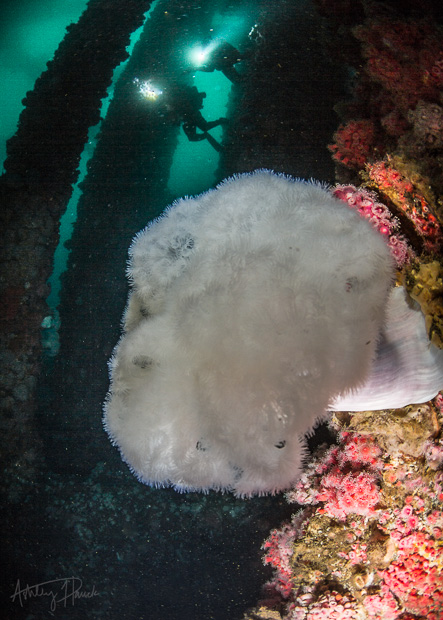Another dive trip to the oil rigs off Long Beach came and went recently, with the typical trifecta of sites: the wreck of the Olympic, the Eureka rig, and the Ellen-Elly twin rigs. The swell prediction leading up to the trip was not encouraging, and surface conditions the day of the trip did not bring any positive surprises. The water was choppy, green, and vaguely opaque–but who needs to see, anyway, right? Down we went.
As is often the case, visibility improved somewhat beneath the top 60 or so feet of muck, but it was still pretty dark down there. It was probably more of a macro day than a wide-angle day, but I wanted to shoot wide-angle, damn it, and so there I was with my dome port, trying like hell to make pea soup into clarified consommé.
One of the biggest adjustments I’ve had to make since trading my compact camera for a digital SLR is having to choose (and stick with) one lens for the entirety of a given dive. The point and shoot, with its one-size-fits-most lens, could shoot pretty good macro and pretty passable wide-angle without changing anything inside the waterproof housing. The SLR does everything better, but at the cost of versatility. I have to pick a focal length (or small range thereof) ahead of time without always knowing what I’ll see.
I generally gauge the success of an underwater shoot by how much post-processing I end up doing in order to engineer a few decent shots. On a good day, a photo might only need a tweak to white balance or a few spots of backscatter removal, or even (miraculously) nothing at all. Other times, I might call upon every shred of my admittedly feeble Photoshop skills in an attempt to produce something worth sharing, and still end up throwing everything away. I think the relative success of any given shoot is directly related to how close I came to selecting the right lens for the conditions.
Those more experienced than I am inform me that this limitation breeds discipline, forcing the photog to research a site and plan shots ahead of time, and creativity, sometimes requiring one to work within the confines of a lens one might not have picked for a certain subject. They’re probably right. I tried this time! I came to the boat with some shots in mind that I wanted to try to get (of, among other things, metridium in black and white), and it definitely did help my success rate.
So, without further ado, the keepers!
The Wreck of the Olympic II
Olympic II was a fishing barge that was hit by the Japanese freighter Sakito Maru during dense fog in 1940. Eight were killed in the collision. She rests in 100 feet of water off the coast of San Pedro, California. Here, my lovely dive buddy Danny was kind enough to model for me.
Eureka and Ellen-Elly Oil Rigs
Our second and third dives were on Eureka and Elly. While the boys harvested scallops (a few of which I had for dinner last night… YUM), I got the metridium shots I had been planning for and cautiously approached some of the biggest cabezon I’ve ever seen. On ascent, we were treated to some cool jellyfish in the shallow, turbid water under the platforms. Be sure to note my super-awesome hot pink bailout tank rigging, which Mat rocked for these dives!













